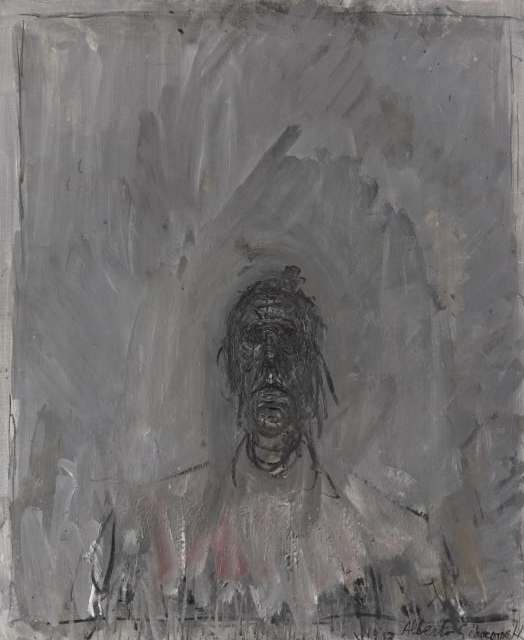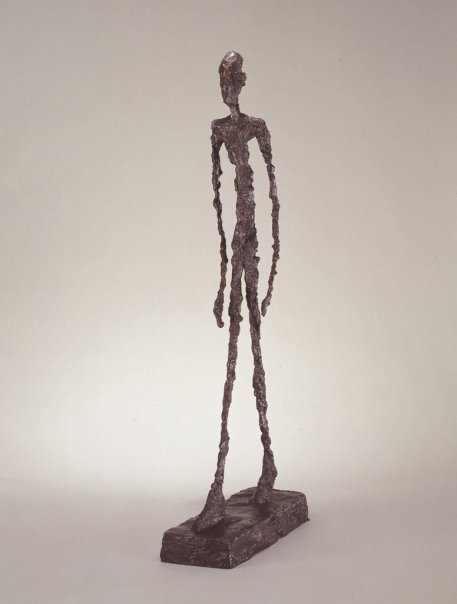Inthe portraits,
the slippery backgrounds echo the depthless grey matter
of space. The astrophysicist, to better grasp the notion
of the boundless, extends an imperfect numerical function
to infinity while the painter drains the colour out of his
pigment for the same effect. Each is asking how brief is
a human life that is bound on all sides by the infinite.
To draw attention
to the largest questions posed by existence, the Swiss artist
Alberto Giacometti (1901-66) decided  that
the portrait would be the optimal place for his inquiry
to take shape and find its proper expression. And even though
in his life time he would come to be regarded by his peers
as a portrait master, he always insisted (in his interviews)
that the moment the sitter took his place he became a mystery.
that
the portrait would be the optimal place for his inquiry
to take shape and find its proper expression. And even though
in his life time he would come to be regarded by his peers
as a portrait master, he always insisted (in his interviews)
that the moment the sitter took his place he became a mystery.
Giacometti’s
special relationship with his amorphous muse (his brother
Diego) was a constant source of angst and exultation, one
which he refused to terminate or resolve to his satisfaction.
His combined obsession and determination – pace Sisyphus
-- to confront the ineffable on its own terms has resulted
in some of the most compelling portraiture in the history
of painting. Both Jean Paul Sartre and Simone de Beauvoir
were fascinated by their painter friend, who was never satisfied
with his work and claimed he was a better writer than painter.
As much as any
artist in the 20th century Giacometti is its designated metaphysician,
in large part because he is not interested in the flesh qua
flesh but in the manner in which the bone structure and skeleton
relate to and anchor the spirit, and call into question the
mostly inscrutable, fugitive aspects of existence.
Why the line,
his gallery of portraits asks, and not the infinite possibilities
inherent in colour?
A line can mark
off what is inside or outside, as in a territory. It is
where inclusion and exclusion meet, and existence  and
non-existence are meshed together and reflected back. Giacometti’s
line, which is a profusion of lines, is less interested
in capturing the likeness of the person than the essence
he embodies, which accounts for the haunting, disembodied
feel to his portraits.
and
non-existence are meshed together and reflected back. Giacometti’s
line, which is a profusion of lines, is less interested
in capturing the likeness of the person than the essence
he embodies, which accounts for the haunting, disembodied
feel to his portraits.
The line, unlike
a volume of colour, invites us to look past or beyond it,
into the dark matter of infinity, into the nothingness that
shadows and animates the subject. Every time the sitter
sits he is confessing that his temporality is not a choice
but a destiny that cannot be double crossed. Where Giacometti’s
restless, nervy lines meet and conflict, man’s essential
humanity is laid bare, but we’re not sure if it is
consequent to the sitter’s momentary expression or
his ambiguous relationship to the infinite.
Giacometti’s
portraits continue the silence that begins with the “Mona
Lisa” and implodes into Edward Munch’s “The
Scream.” It's the silence of wind blowing through
a hollowed out rib cage, of driftwood that is no longer
a tree but whose treeness is indestructible.
Year after year,
it is the same sitter, his brother Diego, whom the artist
claims he doesn’t recognize. By entering this confession
into the public domain, Giacometti is not striking a pose
or bringing attention to his art through the cult of personality.
He is he proposing that in order to know anything at all it
has to be stripped of everything that is familiar at which
point it can be meaningfully encountered?
When the sitter
arrives he brings with him his fears and vanity, confessions
and conceits, and the body with which he negotiates the world,
all of which, under Giacometti’s incisive gaze, are
illusory, as short-lived as a lifetime dropped into the abyss
of eternity. Giacometti’s portraits singlehandedly open
up a realm in the history of art where the artist and his
materials convene in order to reveal man’s essential
fragility and apprehensiveness before the fact of his finitude.
And even though he is uniquely able to draw out and isolate
the metaphysical dimension of existence, paradoxically no
artist has captured appearances more emphatically, more robustly
-- and this holds true for his fleshless, mummy-like sculptures.
Just as Marcel
Proust's À la recherche du temps perdu illustrates
how every life can be rendered meaningful as the first effect
of intentionally reflecting on the past, Giacometti’s
oeuvre invites us to reflect on the possibility of meaningful
existence by rendering strange and foreboding that which
is most near -- the person sitting opposite us. Giacometti
makes it his essential task to strip the sitter of all his
daily entanglements, which conspire to protect him from
his manifest perishability, in order to not humiliate but
free him.
 Since
Giacometti is also a sculptor who must work with solid materials
that withhold transparency and refuse disembodiment, how
is he to make bronze reveal the human condition? How can
tempered bulky matter be converted into a medium that speaks
to man’s existential predicament?
Since
Giacometti is also a sculptor who must work with solid materials
that withhold transparency and refuse disembodiment, how
is he to make bronze reveal the human condition? How can
tempered bulky matter be converted into a medium that speaks
to man’s existential predicament?
Giacometti ingeniously
solves the problem by creating quasi 2-dimensional figures,
many of them drastically reduced in scale. His roughly hewed,
match-stick like figures, such as “Walking Man,”
almost have no breadth, and the heads are shrunk as if the
artist doesn't quite recognize who is before him, while the
withering legs disappear into disproportionately large feet
firmly fixed (nailed) to the ground -- clinging to dubious
epistemological certainties? So delicate and insubstantial
are Giacometti’s sculptures, that like fledging birds
for the first time airborne, we want to take them in our hands
and reassure them that they are here and now and not alone.
By depriving
his bronze figures of their physical human dimension, he
discloses their (man’s) frailty and resolute humanity.
In their attenuated but dignified bearing, he both honours
and defends their terrifying silence as well as their majesty.
And as we stand before them, sometimes towering over them,
we may come to discover our own (diminished) sense of proportion
and the unexpected consolation an encounter with an artwork
can provide.
It requires
repeated acts of courage to make the human condition serve
as one’s lifelong muse, which is why Alberto Giacometti’s
portraits and sculpture rank among the 20th century’s
most significant art.